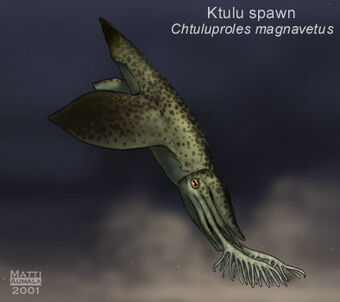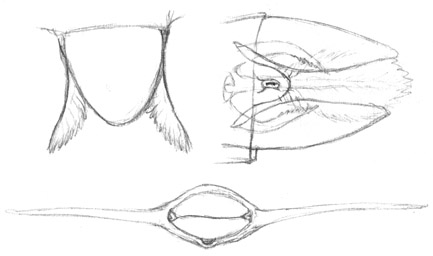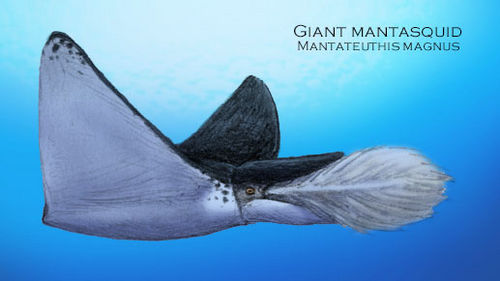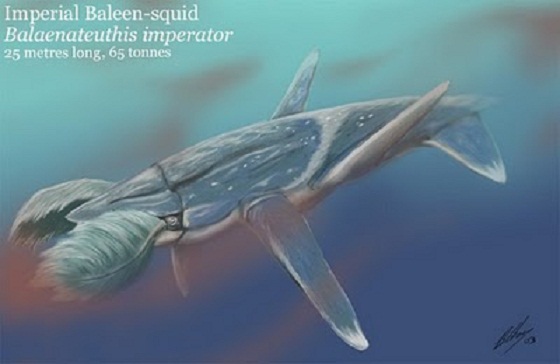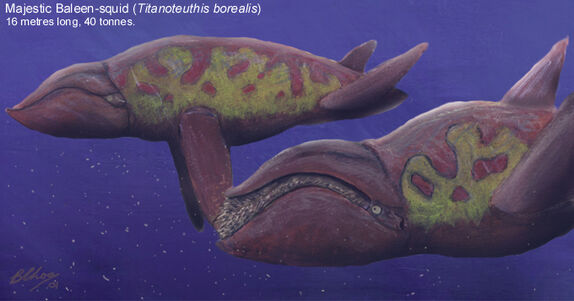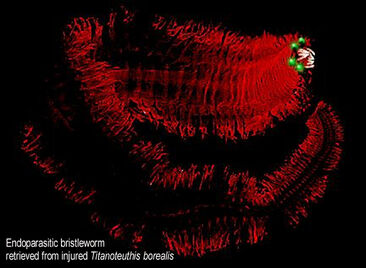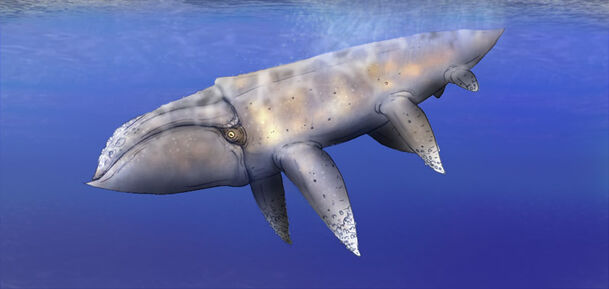INTRODUCTION[]
Some of the weirdest animals on Spec are the balaenateuths or baleen-squids, a diverse group of flippered cephalopods with highly modified tentacles. They range in size from small, mesopelagic gems to immense filter-feeding giants. Absolutely nothing like them exists or has ever existed on Home-Earth.
BIOLOGY[]
As with squid and cuttlefish, balaenateuths possess ten tentacles, two of which are greatly elongated and whiplike. The whips terminate in a cluster of finger-like appendages (giving rise to the term "digibrachia" or finger-arms) that are partially retracted into chambers beneath the mantle when not in use. Six arms are shorter, more conventional-looking tentacles that may be equipped with rows of suckers or hooks. The last two arms, one on the top and one on the bottom, are greatly broadened and often internally reinforced with calcite or cartilage. Only capable of vertical motion, they superficially resemble a set of vertebrate jaws and are sometimes referred to as "gnathobrachia" or jaw-arms.
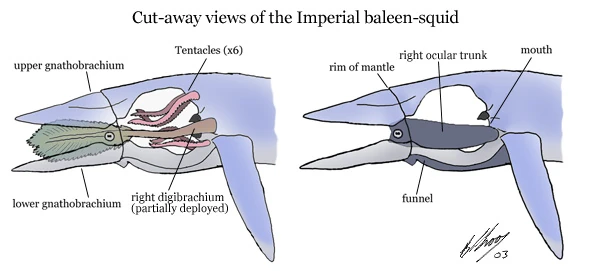
Cut-away diagram of the Imperial baleen-squid revealing the sub-mantle configuration of (left) the tentacles and (right) the ocular trunks. Note that we are looking at the posterior half on the animal and are thus viewing the right-hand side. The resemblance of the squid's posterior to a marine vertebrate's anterior creates the illusion that we are viewing the left-hand side.
Unlike true jaws, these jaw-arms do not bite or chew, their function is purely defensive and hydrodynamic. The large cluster of fingers at the ends of each digibrachia prevents them from being fully retracted into the mantle. If left exposed, the delicate structures would be easily damaged and create significant underwater drag. To prevent this, the jaw-arms can be sealed to form a protective sheath over the ends of the retracted finger-tentacles, creating sleek contours over the posterior of the animal (which, because of the configuration of the jaw-arms, looks like the front of the animal). When the fingers need to be used for feeding, the "jaws" open and the digibrachia are extended outwards.
Aside from the tenticular arrangement, the most striking external feature of the balaenateuths are their flippers. Attached to each side of the mantle are one or more muscular fin-like projections, somewhat like those of their very distant relatives, the vampyromorphs (small deep-sea cephalopods found in both timelines). Beating these flippers provide the primary means of propulsion for the baleen-squid. The siphon, crucial to the hydrojet propulsion of other cephalopods, is now relegated to respiratory and excretory purposes (including the dispersal of ink) having been reduced to a small ventral funnel. Balaenateuths are active swimmers and more massive than a similar sized conventional-squid. As a result, many species have grown to a size where maintaining the jet-propulsion of their ancestors would be impractical.
Both for support and to provide a base for the attachment of musculature, all balaenateuth possess some form of hard or semi-hard internal tissue sunk within the mantle. This ranges from a calcareous plate to a spongy mass similar to an oversized cuttlebone. More advanced balaenateuths possess rods of cartilage within their flippers, performing a function similar to the fin-rays of a shark.
Balaenateuths probably evolved from basal coloid cephalopods (possibly from the same ancestors as Home-Earth cuttlefish) early in the Paleogene. Indeed, the primitive cthulids retain a flattened remnant of the belemnite shell and a simplified (un-chambered) phragmocone to adulthood. Thus, the balaenateuthians are regarded by most marine biologists as a sister group to the primitive Belemoidea, far removed from the more familiar squid and octopodes.
With few hard, shelly parts, the fossil record of these cephalopods is understandably poor. This is compounded by the fact that the earliest baleen-squids possessed complex, bullet-like internal shells very similar to their belemnoid cousins. The more distinctive flattened shells of the cthulids are known from deposits as far back as the Eocene while the blunt beaks of the more advanced baleen-squids appear in the Miocene. The clade probably found favour in the increasing coolness and productivity of the polar seas which led to the appearance of vast swarms of krill. With their high metabolisms and an abundance of food, the giant baleen-squids flourished in this new environment. Today, over 350 balaenateuth species of all shapes and sizes can be found throughout the marine habitats of the world.
CTHULOMORPHIA (Ktulu and ktulu spawn)[]
The cthulomorphs, commonly referred to as wingsquids, are generally viewed as the most basal branch of the balaenateuth family tree. This clade is comprised of benthic predators and scavengers that are probably similar to the original Eocene proto-balaenateuths. Despite this, the cthulomorphs account for nearly one third of extant balaenateuth diversity.
As planktonic juveniles, wingsquids possess well developed siphons and a bullet-shaped internal shell that make them difficult to distinguish from belemnoids. As they age, the shell is flattened into a hard plate (largely replaced by cartilage in the anomaloteuths) that serves as an anchor point for mantle musculature while the funnel is reduced in size. The mantle fringe, that more conventional squid use only for steering, expands enormously to form pairs of fleshy wings that propel the animal through the water. These wings lack the internal support of more advanced balaenateuths. Although no longer their primary means of propulsion, fleeing wingsquid can still rely on their hydrojet for a limited extra-burst of acceleration.
Cthulomorphs also possess the unique jaw-arms formed by the fleshy paddles, but unlike those of more advanced species, they do not form a perfect seal, exposing the bases of the other tentacles when closed.
CTHULIDAE[]
The cthulids or wingsquids are robustly-built forms that feed on or near the benthos. They usually possess a single pair of large propulsive flippers and smaller pair of anterior fins that are used for steering and stability. The fingers on the ends of the comparatively short digibrachia are slender and highly dextrous. These are highly sensitive like the barbels of a catfish, feeling around the seafloor for food. Unlike the catfish, the wingsquid's feelers can also grasp food items and carry them to the mouth.
While most cthulids are less than two metres in length, it is probable that the elusive deep-sea dwelling great ktulu ( Cthulumagnus horridus) is also a member of this family. The great ktulu is kind of Spec cryptid and known only from a few whale-sized rotting hulks washed up on beaches in Vietnam, California, and Hawaii. Many scholars still consider the great ktulu to be only a myth, but the friends and family of the unfortunate deep sea diver and marine biologist George Gilman beg to differ. His last words on his fateful last dive were reportedly: "My god, is that thing a tentacle or...?"
[]
The ktulu spawn is a nocturnal inshore predator, feeding on small animals that burrow in fine sediment such as clams, worms and small fish, probing and agitating the mud with feeler-like fingers. It is found in marine and estuarine environments along the south Asian coast, including mangrove channels. It can use its fins to swim both forwards and backwards, though not nearly as fast and gracefully as the more advanced baleen squids.
The creature's name stems from a misconception that these little creatures were actually the larvae of the cryptic great ktulu of the deep sea. This notion has since been disproved, but the species retains its common name.
ANOMALOTEUTHIDAE (Anomalous squids)[]
The aptly named "anomalous squids" (more popularly referred to as "weirdo squids") are some of the strangest and most enigmatic of Spec's cephalopods. This bizarre family contains over a half-dozen deep-sea predators, most of which remain undescribed. They are characterized by their many (at least five) pairs of mantle-flippers along with a number of derived internal-characteristics that suggest a close relationship to the advanced eubalaenateuths. However, other studies (including biochemical and ontogenetic comparisons) indicate that they should be regarded as unusual relatives of the cthulids.
Weirdo Squid (Anomaloteuthis improbabilis)[]
Anomaloteuths use their flippers to swim either forwards or backwards, somewhat akin to a Home-Earth cuttlefish. While rather slow swimmers, the weirdos are perhaps the most maneuverable cephalopods on Spec. This, combined with their astonishing colour-changing capabilities, allows them to sneak up on unsuspecting prey such as benthic crustaceans and fish as well as smaller cthulomorphs. It grabs these with its highly mobile and unusually strong fingers on the long digibranchia.
Researchers were able to observe the ontongeny of the animal and discovered that the juveniles resembled normal cthulid wingsquids for the first weeks of their life. As they developed, the young would grow additional pairs of flippers near the base of the mantle, each new pair pushing the older one further up the body (away from the foot) until all six pairs were present.
Up until then, researchers considered the number of mantle-flippers to be a key character in determining the evolution and interrelationships of the baleen-squids. It was obvious that the cthulids, which possessed only two well-developed flippers, were the most primitive members of the clade. It was thus assumed that "more flippers" translated to "more derived" thus the two-flippered mantasquids were considered "primitive" while the eight-flippered Lumenateuthis was "advanced".
The weirdo squid threw a spanner in the works in being a primitive cthulid-like balaenateuth with the greatest number of flippers in the clade. Further research has determined that the baleen-squids acquired many-flippers early in their history and, have been losing and regaining pairs of fins throughout their evolution to the point that their number does not accurately represent phyletic position. We now know that the eight-flippered glowsquids are the most basal of the eubalaenateuths while the mantasquids are an "advanced" sister-group of the giant 4-6 flippered balaenateuthids.
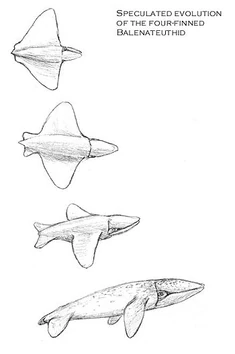
Popular model of baleen-squid flipper evolution that was proven to be incorrect with the discovery of Anomaloteuthis.
A new wingsquid species discovered from the depths of the Spec Pacific may force evolutionary biologists to reevaluate their views on baleen squid evolution.
The new species has been named Anomaloteuthis improbabilis and assigned to its own genus within Cthulidae, a clade of primitive balaenateuthid cephalopods thought to resemble the ancestors of the baleen squids.
This species is however unlike any other cthulid discovered so far. The genus name Anomaloteuthis stands for "anomalous squid" but is also an allusion to a strange Cambrian predator Anomalocaris which shared some features with the newly discovered cephalopod. "This does not mean they are related any more than sharks and dolphins are," said Specworld cephalopod expert Rauno Turisas, a member of the team responsible for the discovery. "The similarities can all be explained with convergent evolution."
The unique anatomy of the animal came as a suprise to the team. "Anomaloteuthis has this row of flippers startingfrom the rim of the mantle, which isn't seen in any other balaenateuths," Turisas said. "You'd really expect a structure like this to be an unbroken fin instead of split into several flippers." Most cthulids indeed have just two large flippers that form from the rim of the mantle. Turisas has had the opportunity to observe the ontogeny of Anomaloteuthis, and found the origin of its multiple flippers.
"Anomaloteuthis larvae look like normal wingsquids for the first weeks of their life. After that they grow a new pair of flippers just next to the first, then another, and another, until they have six pairs of them," he said. "They're really something else."
Anomaloteuths use their flippers to swim either forwards or backwards, somewhat akin to RL cuttlefish. "They aren't built for speed," said Penelope Gilman, who has studied Anomaloteuthis behavior for the past year, "but they are perhaps the most maneuverable cephalopods in Spec." Anomaloteuths use this maneuverability to silently sneak up on their prey which they catch with special tentacles that lack suction cups but ending in finger-like extensions.
While Anomaloteuthis may externally appear to differ from other wingsquids only by its unusual flippers, there are more differences in internal anatomy. "Anomaloteuthis has a complex nervous system closer to that of baleen squids than other cthulids. It can also change its color very rapidly," Gilman said. Anomaloteuthis has also almost completely lost its internal shell.
"Anomaloteuthis is a curious combination of primitive and derived characteristics," says specevolutionist Sam Ling. "It's certainly going to cause some headaches back on home-earth." According to the current theory the four-flippered baleen squids evolved from a two-flippered animal resembling the mantasquids. The huge "wings" formed from the mantle would at some point have split in two forming the two pairs seen in modern baleen squids.
There have however been people suggesting that the slowly plodding mantasquids and actively hunting baleen squids evolved baleen feeding independently from each other. Now some see Anomaloteuthis as an indirect proof of this.
"Despite its primitive features, the feeding technique of Anomaloteuthis admittedly has some similarities with that of the imperial baleen squid," says Ling. Still she doesn't believe anomaloteuths are closely related to the ancestors of baleen squids. "It appears to me that we're looking at a case of convergent evolution rather than a living fossil. Anomaloteuthis is just doing what baleen squids did some thirty million years ago."
from Spexploration Weekly
EUBALAENATEUTHIA[]
The true baleen-squids of clade Eubalaenateuthia have probably undergone the most radical evolutionary modifications of any cephalopod. In many ways, these creatures are more like vertebrate fish than mollusks. They have forsaken jet-propulsion entirely, relying instead on two to eight powerful mantle-flippers to move them around. These are supported by internal rods composed of cartilage and calcite that has transformed them from being the floppy structures of their ancestors into strong, hydrodynamic paddles. Compared to more primitive balaenateuths, they are vastly more powerful swimmers, spending most of their life moving backwards with their tentacles to the front.
The main mantle body is stiffened by a huge internal mass of spongy, calcareous matter similar to a cuttlebone. Within a tube inside this "backbone" resides a large neuron growth, forming a dorsal nerve chord that transmits high-bandwidth information from one end of a body to the other. The bases of the tentacles have retreated deep into the mantle cavity and reside in a huge preoral chamber. Except when feeding, the only visible limbs are the two enormous gnathobrachia which clasp together to resemble a giant vertebrate mouth. To maintain their position external to the mantle, the eyes and funnel are situated on the end of three broad trunks.
All eubalaenateuths are filter-feeders, straining small shoaling fish and invertebrates from the water with their specially modified digibrachia. Unlike the simple digits of more primitive baleen-squids, the greatly elongated fingers feature a complex array of branching fibres that has turned them into giant feathery sieves or "baleen tentacles" . These are used like the baleen plates of HE whales, trapping tiny animals in their filaments as water is forced through them.
Once loaded with trapped plankton, the baleen-tentacles retract into the preoral chamber where the six shorter tentacles gather the catch from the bristles and transfer it to the mouth. Since their prey is too small to require biting or chewing, the beak is broad and blunt. The six short feeding-arms of species that feed on tiny zooplankton possess a sticky, roughened surface that trap food as they run through the baleen-bristles , effectively acting as tongues. Baleen-squid that feed on larger food items like schooling fish use their feeding-arms the old fashioned cephalopod way, grabbing prey with hooks and suckers.
LUMENATEUTHOIDEA[]
Although containing over 130 species, the lumenateuthoids are rarely seen and poorly understood with family-level relationships still being determined. They are mesopelagic planktonivores of the open oceans, rarely over a metre in length. Many possess glowing chromatophores along their bodies that has given rise to the name "glowsquids". Very little is known of their habits although they are assumed to be vertical migrators, following clouds of plankton to near the surface at night and into the depths during the day.
Rosy Sea-Dragonfly (Tetraptera kempae)[]
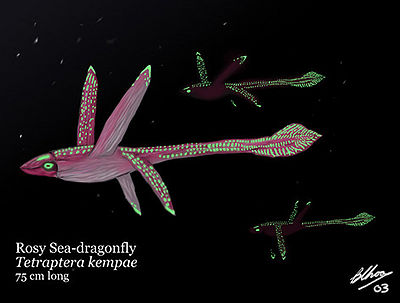
Rosy sea-dragonfly, Tetraptera kempae (Patchy circumglobal distribution in tropical to cool-temperate seas)
This highly ornate species gathers in large "flocks" and is seasonally abundant in certain productive areas like the Great Australian Bight. Normally found at depths of well below 300 metres, it has been known to gather near the surface during full-moonlit nights, making the seas appear ablaze with green fire. It feeds primarily on tiny crustaceans which it captures with very finely-bristled digibrachia. When threatened, it releases a cloud of luminescent ink.
The sea-dragonflies of the genus Tetraptera are characterized by their four extremely long flippers and a long, standard-like anterior extension covered in glowing biolights.
Brooch Glowsquid (Lumenateuthis lampkisnsi)[]
This laterally compressed, eight-flippered species is widely distributed but very infrequently caught. Most specimens have been recovered at depths of 500-2200m, well above the bottom. A striking feature of this genus is the glowing lure (which may be switched off at will) attached to an erectile trunk on the lower gnathobrachium. The light generated by this lure may be of intense brightness and attracts all manner off zooplankton to within easy reach of the pink baleen-tentacles. Although primarily planktonivorous, brooch glowsquid are not picky-feeders and will consume anything small enough to fit in it's maw and dumb enough to swim to the light. Most creatures at this depth cannot see into the red part of the spectrum, thus the brightly coloured digibranchia are effectively invisible.
ALANATATORIDAE (Mantasquids)[]
Aptly referred to as mantasquids, the Alanatatoridae possess a single pair of enormous wing-like flippers that beat with graceful wing-like actions. Alanatatorids are stately swimmers, slowly cruising through the upper levels of the ocean like giant flapping birds. It is as yet unclear whether these wings represent the extension of a single pair of flippers or are rather the fusion of multiple smaller flippers into a larger compound fin.
Mantasquids feed by extending their baleen-tentacles while swimming through a plankton-swarm. Tiny animals become trapped in the long bristles while larger prey items are funneled into the maw where they are grasped by the shorter feeding arms.
Giant Mantasquid (Mantateuthis magnus)[]
Largest of the alanatatorids, the 10-metre wide giant mantasquid is found worldwide in tropical seas. They are a common sight along reef fringes where they feed on the spawn of corals and other reef organisms. Larger individuals also feed on pelagic crustaceans and small fish.
A little has been gleaned about the breeding habits of this titan. Mating generally coincides with synchronized reef-spawning during summer full moons, the only time large numbers of mantasquids gather as they feast on the clouds of eggs and sperm in the water. Males congregate around receptive females, easily recognised by the large white dorsal blotches that are clearly visible in the moonlight. The males slowly jostle each other for access to the female until one barges it's way through and inserts a sperm packet beneath her mantle rim or into her funnel with an elongated feeding tentacle.
The female may accept sperm from one to four different males before the white blotches vanish (signalling that she is accepting no further advances) and the males promptly lose interest in her. After carrying the sperm for a variable length of time, the female produces up to six large, cigar-shaped eggs that she sticks to the inside of her preoral chamber. She continues to feed during the incubation (the length of which remains unknown) before ejecting fully-formed pups over 40 cm in width that may accompany their mother for a time. Unlike the giant balaenateuthids (see below), mating does not lead to significant mortality and both sexes may live to be over 12 years of age.
Dwarf Mantasquid (Alanatator minor)[]
A native to the waters off the coast of the Australia and similar areas, the dwarf manta squids, the smallest of the mantasquids, are a very common sight among Spec’ Great Barrier Reef. These small, but graceful squids are known to swim acrobatically through the water, to usually pursue smaller prey in the area. Predators include hesperornithids, sharks, the kronoshark to being the most obvious example of course, and mosasaurs in the area.

The dwarf mantasquid, Alanatator minor (Great Barrier Reef), and the striated butterfly squid, Papilloteuthis striatus (Great Caribbean Reef) , two typical mantasquid genera.
Striated Butterfly Squid (Papilloteuthis striatus)[]
Related to Mantateuthis, the Striated Butterfly Squid gets its name due its appearance and that its flies gracefully through the tropical waters like a massive underwater butterfly.. Like its relatives, they tend to glide gracefully through the water in search of smaller prey. Despite being not as large as the Mantasquid, these creatures are still a spectacular sight non the less.
BALAENATEUTHIDAE (Baleen-Squids)[]
Wingsquids and mantasquids are all well and good, but the image conjured up by the word "balaenateuth" are the true colossi of the cephalopod world, the giant baleen-squids. Except perhaps for the dinosaurs, Spec's giant baleen-squids, clade Balaenateuthidae, are our world's most famous fauna.
The baleen-squid are the mysticete-whales of Spec. While some sharks and teleost fishes have made a pass at the giant planktonivore niche, it was the cephalopods that mastered it, growing to tremendous sizes, swallowing entire food chains into their tentacular maws. Balaenateuthids fall into 2 broad categories with regards to feeding. Some, like the imperial baleen-squid are active pursuers of plankton, charging into clouds of krill and shooting out their baleen-tentacles to grab their food like some oversized barnacle. Others rely on a more passive skimming method, cruising forwards with their gnathobranchia open, passing water through their baleen-tentacles to filter out small animals. In these forms, the baleen-tentacles do not extend far out of the maw. Balaenateuths are extremely intelligent and, incredible as it sounds for a mollusc, vocal. By playing their radula against a large plate on the roof of the throat, the cephalopods can produce a wide range of clicks, buzzes and tones. Precisely how they hear these complex calls has yet to be determined.
Imperial Baleen-Squid (Balaenateuthis imperator)[]
The imperial baleen-squid is the largest invertebrate to have ever existed. There just aren't enough superlatives to describe the power, splendour and sheer, otherworldly weirdness of this behemoth. The imperial can be found in all the world's oceans from the frigid poles to the warm tropics. A pelagic species, it rarely comes near the coast except in polar regions where they follow the retreating ice-edge as summer progresses. They undertake regular, annual migrations from low to high latitudes, covering thousands of kilometres each year. During summer, they congregate in polar waters to harvest the dense shoals of krill, gathering the crustaceans with their giant baleen-tentacles as soon as they are exposed by the melting ice.
With the approach of winter, the squid disperse to warmer seas and the situation becomes a little complex. Based on exhaustive studies of South Pacific populations, the majority of adult males and about 40% of adult females head towards specific breeding sites near nutrient-rich upwellings (one known breeding site is situated over the Kermadec Trench). Mating is an exceedingly violent affair as the males, resplendent in breeding chromatophore-regalia, seek to couple with the females. As there is always a surplus of males to each receptive female, violent melees regularly break out with animals bashing and ramming each other or locking gnathobrachia. Horrific injuries abound including torn mantles, ripped flippers or broken jaw-tentacles. The actual coupling is brief with successful suitors spearing their partners with a modified feeding-tentacle, inserting a sperm-packet beneath the mantle.
Each successful male mates once per season and quickly discards his breeding markings before feeding ravenously on whatever swarming plankton they can find in as they recover from their ordeal. Females may accept sperm from multiple partners and remain for longer, feeding sporadically. Assuming their injuries are not too severe, the breeded males quickly regenerate and leave the mating grounds while their less successful brethren usually die from their injuries or continue battling until succumbing to exhaustion or predators. Each season, more than a quarter of the males (and a few females) find the reproductive urge to be a fatal attraction. Rare indeed is the male that survives more than three winters of breeding but he will have been rewarded with many offspring to carry on his genetic legacy. Mating only once every two years, a female imperial can expect to live to over a decade as a breeding adult.
By midwinter, the breeding season is over and the orgiastic crowds have dispersed. During the next summer, the sperm-laden females glut themselves at the poles, each fertilized female laying over a thousand eggs wrapped in a floating jelly-like mass. She quickly scoops up the mass in her maw and pastes it in place within the relative safety of her preoral chamber. Even when carrying her spawn, the mother is still capable of feeding. The following winter, the "pregnant" female avoids the breeding grounds and travels alone to the tropics where, after a four month incubation, she releases a swarm of inch-long offspring and abandons them to their fate. Precisely how long the juveniles roam amongst the tropical plankton is unknown, but each year, fresh batches of13-metre long newcomers appear at the polar feeding grounds.
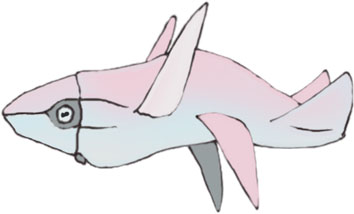
Juvenile Balaenateuthis sp. (probably B. imperator). This 13 cm long specimen was caught in the Central Pacific at a depth of 950 metres.
Majestic Baleen-Squid (Titanoteuthis borealis)[]
The majestic baleen-squid is the largest of the skimming balaenateuths. Majestics live within Arctic and sub-arctic waters and spend much of their time close to the edge of the ice, where they feed on very small zooplankton, primarily copepods, steropods and mysids. Non-migratory baleen-squids like the majestic tend to spend more time in close association with others of their kind and rely more on visual communication than those which disperse to migrate (and thus rely more on vocalization to keep in touch over long distances). The majestic baleen-squid has a beautifully patterned mantle. When an animal is near others of it's kind, it is able to alter these patterns thanks to fantastically coordinated chromatophore activity, creating the illusion of blobs breaking off the red dorsal stripe and slowly traveling across the yellow flanks, often fusing with other blobs to form larger ones. This is the source of this animal's nickname, the "Lava-lamp whale". Precisely what these signals convey is unknown.
Endoparasitic bristleworm (Genus unknown)[]
This unnamed creature, recovered from the body of a majestic baleen-squid, looks like a science-fiction alien. To a Home-Earth biologist, however, the worm is far more familiar than its balaenateuth host. It is, in fact, a bristleworm, a member of the class Polychaeta, a group of annelids quite common on Home-Earth. This one has clearly adopted a commensal lifestyle, living among the filter-tentacles of its host and feeding on trapped invertebrates and fish larvae the squid has yet to swallow. The reproductive cycle of this organism is unknown.
Grand Baleen-Squid (Megacalamari grandis)[]
This enigmatic, 14-metre long giant is found throughout the temperate and subtropical oceans of the Southern Hemisphere. A rare, solitary species, it is one of the lesser known of the giant balaenateuths and much remains to be discovered about its reproduction and seasonal movements. Sometimes placed in the same genus as its close relative, the majestic baleen-squid, the grandis shares its northern cousin’s skim-feeding habits, using it’s feathery digitibrachia to strain copepods and krill from the water. While normally a dull-greyish colour, it is capable of producing a display of yellow and bluish patches along its flanks when in the company of others of its kind.
- Brian Choo , Daniel Bensen , Drhoz and Matti Aumala
,=Cthulidae=Chtuluproles magnavetus (Ktulu spawn)
,=Cthulomorphia=|
| `=Anomaloteuthidae=Anomaloteuthis improbabilis (Weirdo squid)
,=Balaenateuthia=|
| ,=Tetraptera kempae (Rosy sea-dragonfly)
| ,=Lumenateuthoidea=|
| | `=Lumenateuthis lampkinsi (Brooch glowsquid)
| |
`=Eubalaenateuthia=| ,=Alanatatoridae=Mantateuthis magnus (Giant mantasquid)
| |
`=|
| ,=Titanoteuthis borealis (Majestic baleen-squid)
| ,=Titanoteuthinae=|
`=Balaenateuthidae=| `=Megacalamari grandis (Grand baleen-squid)
|
`=Balaenateuthinae=Balaenateuthis imperator (Imperial baleen-squid)


